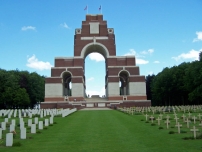| First Name: | Arthur | Last Name: | COOPER | |
|---|---|---|---|---|
| Date of Death: | 07/07/1916 | Lived/Born In: | Earlsfield | |
| Rank: | Private | Unit: | West Riding9 | |
| Memorial Site: | Thiepval Memorial, France | |||
Current Information:Born-Westminster
The Battle of the Somme (July-November, 1916) On 1st July 1916 The British Army launched a massive offensive along a section of the front line running north of the River Somme while the French attacked south of it. The first day was a disaster for the British army which suffered nearly 60,000 casualties, 19,000 of whom were killed, and made hardly any inroads into the enemy lines. But the battle had to go on, if for no other reason than to relieve pressure on the French at Verdun where they had been facing the full onslaught of the powerful German Army. So it continued all the way through to November with nearly every battalion and division then in France being drawn into it at some stage. In the end the German trenches had been pushed back a few miles along most of the line but the cost in lives had been staggering. By the end of the fighting in November, 1916, British Army casualties numbered over 400,000, killed, wounded and missing. The days immediately following the carnage of July 1st on the Somme, had two main priorities. They were to rescue the wounded and to consolidate what gains had been made. However, despite the slaughter of 1st July, there was no going back. This was the “Big Push” and the attacks had to continue and Haig decided that they would continue on the southern sector of the front where the few successes had occurred. The first two weeks of the battle saw Fourth Army pushing forward towards the German second line from Contalmaison, through Mametz Wood to Trones Wood. The problem was that these attacks were uncoordinated, with Divisions and Corps operating independently and without direction from Army HQ. In a series of isolated operations the British Army struggled forward and took territory but the price in human life was far higher than it should have been. An example of this was the attempt by 17th Division to capture the village of Contalmaison on 7th and 8th July. By this time the weather had broken and the rain had reduced much of the battle ground to mud making any movement forward even harder. At 2am on 7th July, 1916, 17th Division launched a preliminary attack, after a 35 minute bombardment, in an attempt to gain the re-entrant formed by Quadrangle Support Trench and some of Pearl Alley. This would give them more favourable positions west of Mametz Wood and south of Contalmaison from which to launch the main attack at 8am. 9th Northumberland Fusiliers and 10th Lancashire Fusiliers of 52 Brigade moved forward but found the Germans waiting for them and the wire uncut. To add to their woes, British shells, falling short, fell among their leading waves. Even so, some men on the left managed to get into Contalmaison but both battalions were eventually forced back. They tried once more with no better fortune and eventually they withdrew. The enemy then counter-attacked but were driven off. However this fighting disrupted the preparations for the main attack at 8am which was put back 30 minutes to allow for an extra bombardment which began at 7.20am. At 8am, the12th Manchester and 9th West Riding battalions of 52 Brigade attacked Quadrangle Support Trench in broad daylight. Delayed by some companies unable to make it to the start line on time, they attacked too late, lost the protective barrage and were cut down by machine guns firing from Mametz Wood. Among their casualties suffered by 9th West Riding was Arthur Cooper who was killed in action. |
||||
| « Back to Search Results | ||||
| If you think any of the information shown here is incorrect, Click Here to submit your amends and comments | ||||




